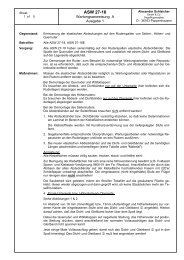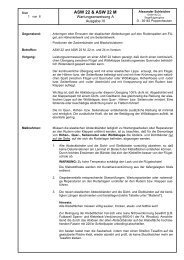ASK 21 - Alexander Schleicher
ASK 21 - Alexander Schleicher
ASK 21 - Alexander Schleicher
Create successful ePaper yourself
Turn your PDF publications into a flip-book with our unique Google optimized e-Paper software.
<strong>ASK</strong> <strong>21</strong><br />
The <strong>ASK</strong> <strong>21</strong> is a two-seater midwing with 17m span. This aircraft stands out particularly by its wide range of<br />
flying tasks. The <strong>ASK</strong> <strong>21</strong> accompanies the student pilot from instruction up to the first cross-country or competition<br />
flights. The experienced pilot may use its suitability for aerobatics and cloud flying. Its easy handling<br />
on the ground as well as in flight must also be pointed out. The high production quality, as well as the lowmaintenance<br />
and very rugged design offer a versatile aircraft for everybody, fit for every-day service and<br />
lasting in value. It is an acquisition which pays off for syndicates and clubs.<br />
The fuselage shell offers to the pilot a high level of passive accident safety. The plexiglass canopies are<br />
hinged fore and aft and together with the upwards hinging instrument panel in the front seat they offer a<br />
comfortable entry and exit. The layout of the canopy locking levers and the fitting of a canopy interlock<br />
mechanism guarantee reliably the locking of the canopies, particularly of the rear canopy which is valuable<br />
on solo flights or when carrying passengers.<br />
The comfortable rubber-shock-mounted landing gear not only absorbs the smaller bumps which are common<br />
on every take off and landing, but is also very forgiving of heavy landings. Especially flight instructors<br />
appreciate after a long instruction day the convenience of the comfortable non-fatiguing seat position and of<br />
the easy-to-use and easily accessible operating levers.
<strong>ASK</strong> <strong>21</strong><br />
A true instruction sailplane<br />
The <strong>ASK</strong> <strong>21</strong> is a design by Rudolf Kaiser, one of the most<br />
famous sailplane designers of our times.<br />
Already with the predecessor sailplane type <strong>ASK</strong> 13 he succeeded<br />
to design an aircraft which came up to all requirements<br />
of instruction and performance flying. And with the <strong>ASK</strong> <strong>21</strong><br />
Kaiser was successful in conveying the good characteristics of<br />
the <strong>ASK</strong> 13 also to the fiber composite construction. Meanwhile<br />
more than 750 units have been built and so the <strong>ASK</strong> <strong>21</strong> may be<br />
regarded as the standard type of instruction sailplane.<br />
Now as before „up to date“<br />
It is not only its elegant appearance on the ground and in flight<br />
which makes clear that Rudolf Kaiser has designed the <strong>ASK</strong> <strong>21</strong><br />
very far-sighted at the time. Even after being in production since<br />
some years already, the <strong>ASK</strong> <strong>21</strong> still comes up to all requirements.<br />
With this two-seater the student and the solo pilot gets<br />
an aircraft which stands out for easy handling and extremely<br />
harmless flight characteristics. Particularly the excellent low<br />
speed flight characteristics together with its low all-up weight<br />
work out very positively in weak thermals. Moreover, the low allup<br />
weight pays off also for winch launches where considerably<br />
more height in tow is gained compared to bigger and heavier<br />
two-seaters. This is a pre-condition for an effective instruction<br />
operation in flying circuits or for reaching thermals.<br />
The good glide ratio enables pilots to gain with the <strong>ASK</strong> <strong>21</strong> their<br />
first experience in cross country or competition flights. Another<br />
quite new thing was that the <strong>ASK</strong> <strong>21</strong> got type certification for full<br />
aerobatics and for cloud flying. It is certified for the following<br />
aerobatics: Loop, Turn, Split 'S', Immelmann, Slow Roll, Steep<br />
Climbing Turn, Chandelle, Lazy Eight and Inverted Flight.<br />
Its easy ground handling due to the low tail weight and low allup<br />
weight must also be pointed out.<br />
Handicapped pilots flying a sailplane ?<br />
In order to enable also pilots with disabled legs to do gliding,<br />
some <strong>ASK</strong> <strong>21</strong> have already been modified accordingly. <strong>Schleicher</strong><br />
offers to this purpose a modification kit where the rudder is<br />
2<br />
actuated by means of an additional hand lever at the left cockpit<br />
wall. The airbrake lever engages in a similar way as a flap lever<br />
so that one hand is free to actuate the rudder.<br />
The additional actuating levers are easily and quickly removable<br />
so that the <strong>ASK</strong> <strong>21</strong> can also be operated in the usual way.<br />
Experience with the operation of such modified <strong>ASK</strong> <strong>21</strong> has<br />
shown that the actuating levers are ergonomically very well laid<br />
out and stand out for low actuating forces.<br />
Design Service<br />
It is often the small details which improve the every-day suitability<br />
of an aircraft. as e.g. the front instrument panel being designed<br />
to hinge upwards with the canopy which offers a comfortable<br />
entry and exit.<br />
The layout of the canopy locking levers and the fitting of a<br />
special canopy interlock mechanism guarantee reliably the<br />
locking of the canopies, particularly of the rear canopy which is<br />
valuable on solo flights or when carrying passengers.<br />
High Production Quality and Safety<br />
The high production quality which is known from <strong>Schleicher</strong><br />
products, as well as the well-devised and low-maintenance<br />
design offer an aircraft which is fit for every-day service, versatile,<br />
and lasting in value, for everybody. Thanks to its easy and<br />
unproblematic handling this aircraft can and may surely be<br />
flown by everybody. It is an acquisition which pays off for syndicates<br />
and clubs.<br />
Also just its use in the harsh instruction conditions has demonstrated<br />
that the <strong>ASK</strong> <strong>21</strong> is a very rugged aircraft without any<br />
teething troubles.<br />
Particular attention was paid to the crashworthiness of the<br />
<strong>ASK</strong> <strong>21</strong>. Not only the automatic elevator connection but also the<br />
construction of the fuselage contribute considerably to the safe<br />
operation of the aircraft. For example, the fuselage shell is a<br />
rugged GRP tubuscore honeycomb sandwich which affords the<br />
pilot a high level of passive accident safety with low weight of<br />
structural components.
Standard Equipment:<br />
The basic version of the sailplane <strong>ASK</strong> <strong>21</strong> already gives you a<br />
liberally equipped aircraft:<br />
The double-wall fuselage shell uses an 8 mm thick tubus core<br />
between both supporting GRP laminate skins. This sandwich<br />
construction provides a safety cockpit which gives the pilot a<br />
maximum possible protection in case of emergency.<br />
The automatic elevator connection prevents effectively the<br />
possibility of taking off without connected elevator.<br />
The canopy closing system with the interlock mechanism adds<br />
further to the safety.<br />
The plexiglass canopies are hinged fore and aft; having the<br />
advantage of an efficient tongue and groove type sealing.<br />
The two largely dimensioned rubber-shock absorbers of the<br />
landing gear and the large 5.00-5 main wheel are very forgiving<br />
DESIGN SPECIFICATION<br />
<strong>ASK</strong> <strong>21</strong><br />
of heavy landings. Also the smaller bumps which are common<br />
on every take off and landing are well absorbed thus saving the<br />
backbone of the flight instructor.<br />
Rudder pedals and seat back rests are comfortably adjustable<br />
in both seats. There is ample space also for tall pilots.<br />
All operating levers are easy-to-use and easily accessible.<br />
Adjustable and pivot-mounted fresh air nozzles at the cockpit<br />
wall provide sufficient cockpit ventilation.<br />
It goes without saying that the installation of tow release couplings<br />
for winch launch as well as for aero tow is standard.<br />
The push rods of aileron, elevator, and airbrakes are running<br />
smoothly in anti-noise ball-bearings. The actuating levers and<br />
bellcranks use also ball bearings which guarantee smooth<br />
running and long service life. The rudder is actuated by steel<br />
cables.<br />
Two-seater sailplane, fiber composite construction, midwing configuration with T-tail, for instruction,<br />
aerobatics and performance flying.<br />
FUSELAGE GRP tubuscore honeycomb sandwich fuselage with roomy safety cockpit. In flight adjustable rudder<br />
pedals, front & rear. TOST C.G. tow release coupling and TOST aero nose tow release coupling.<br />
Rubber-shock-mounted landing gear with large 5.00-5 tire. Hydraulic disc brake which is connected to<br />
the airbrake lever. Fixed nose wheel 4.00-4. Rubber-shock-mounted tail skid or (as optional extra) tail<br />
wheel <strong>21</strong>0 x 65. Cockpit ventilation through adjustable fresh air nozzles at the right cockpit wall.<br />
CANOPIES AND<br />
INSTRUMENT PANELS The full-vision plexiglass canopies are hinged fore and aft. Canopy interlock mechanism to guarantee<br />
safe locking of the rear canopy. The front instrument panel is made to hinge upwards with the canopy;<br />
even when the canopy is open, the instruments are still covered.<br />
WING The two-part double-tapered wing is built as a fiberglass sandwich with PVC hard foam core and GRP<br />
roving wing spars. Large dive brakes on the wing upper surface. Straight-forward wing assembly by<br />
conventional tongue and fork spar extension with two cylindrical main pins.<br />
CONTROL CIRCUITS AND<br />
FITTINGS Aileron, elevator, and airbrakes are actuated by push rods running in anti-noise ball-bearings. The<br />
actuating levers and bellcranks use also ball bearings. The rudder is actuated by steel cables. Levers<br />
and fittings are welded steel or milled Duraluminium respectively.<br />
TAILPLANE T-tail (elevator with stabilizer) in GRP-hard foam sandwich-construction. Control surfaces partly mass<br />
balanced. Low actuating hand forces. Elevator trim via a trim lever next to the stick. Automatic elevator<br />
connection. VHF-antenna in the fin.<br />
BOARD EQUIPMENT AND<br />
ACCESSORIES Pitot in the fuselage nose. Static pressure vents (for the A.S.I.) in the fuselage tail boom left and right.<br />
Connector for Total Energy tube on the fuselage top. VHF-antenna in the fin. Seat cushions front &<br />
rear. 5-part safety harnesses.<br />
OPTIONAL EXTRAS Fixed tail wheel (<strong>21</strong>0 x 65), aerodynamically well faired. Trim weights mounting support for 10 x 1 kg<br />
lead plates. Mounting support for 2 oxygen bottles à 4 liters. Tail dolly. Mounting support for barograph.<br />
3
<strong>ASK</strong> <strong>21</strong><br />
TECHNICAL DATA<br />
Span 17 m 55.77 ft Wing loading (85 kg payload) 24.5 kg/m² 5.01 lbs/sqf<br />
Wing Area 17.95 m² 193.<strong>21</strong> sqft Wing loading (200 kg payload) 31.0 kg/m² 6.34 lbs/sqf<br />
Wing aspect ratio 16.1 16.1<br />
Payload cockpit front max. 110 kg 242.5 lbs<br />
Fuselage length 8.35 m 27.39 ft Payload cockpit rear max. 110 kg 242.5 lbs<br />
Cockpit height 0.90 m 2.95 ft<br />
Cockpit width (clear width) 0.68 m 2.23 ft Max. speed 280 km/h 151 kts<br />
Height at tailplane 1.55 m 5.08 ft Min. speed (single-seated) 62 km/h 33.4 kts<br />
Min. speed (two-seated) 65 km/h 35 kts<br />
Wing airfoil Wortmann FX S 02-196<br />
and FX 60-126 Maneuvering speed 180 km/h 97 kts<br />
Dive brakes extended up to 250 km/h up to 135 kts<br />
Maximum load factor (180 km/h) +6.5 -4.0<br />
Maximum load factor (311 km/h) +5.3 -3.0 Minimum sink (single-seated) 0.65 m/s 128 ft/min<br />
Empty mass with min. equipment appr. 360 kg ~ 794 lbs Glide ratio (single-seated, at 85 km/h) 34 34<br />
Max. take-off mass 600 kg 1323 lbs Glide ratio (two-seated, at 90 km/h) 34 34<br />
<strong>Alexander</strong> <strong>Schleicher</strong> GmbH & Co. Segelflugzeugbau<br />
D-36163 Poppenhausen (Wasserkuppe) <strong>Alexander</strong>-<strong>Schleicher</strong>-Straße 1<br />
D-36161 Poppenhausen (Wasserkuppe) P.O. Box 60<br />
Tel. ++49 (0) 66 58 / 89-0<br />
Fax ++49 (0) 66 58 / 89 40<br />
e-mail: info@alexander-schleicher.de<br />
homepage: www.alexander-schleicher.de<br />
Design and construction subject to change without prior notice. Issue: July 2003



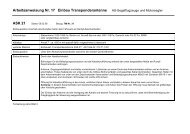


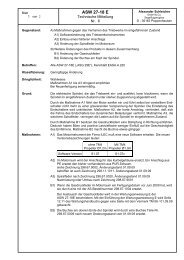
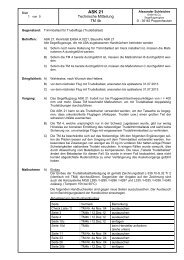
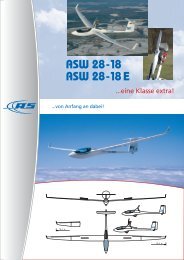



![AD 2012-0246 [PAD 12-122 task 2012.251] Schleicher-Ka6 K7 K8 ...](https://img.yumpu.com/8336662/1/184x260/ad-2012-0246-pad-12-122-task-2012251-schleicher-ka6-k7-k8-.jpg?quality=85)


